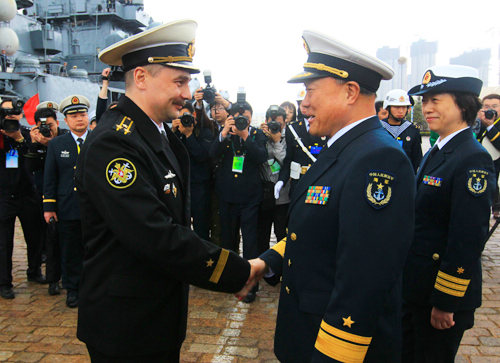|
 |
|
HAND IN HAND: Du Xiping (second left), Deputy Commander of the PLA's North Sea Fleet, shakes hands with a senior Russian officer at a welcome ceremony for the arrival of the Russian fleet in Qingdao, east China's Shandong Province, on April 21 (ZHA CHUNMING) |
"The joint drill opens a new approach for the Chinese Navy by including anti-terrorism and conventional combat missions in the exercise," Chen said.
The Yellow Sea is the most sensitive region in the west Pacific Ocean because the military confrontation on the Korean Peninsula has not ended. Guided by U.S. President Barack Obama's new strategy, the United States is pivoting to the Asia-Pacific region. At present, nearly 60 percent of the U.S. navy is in the west Pacific Ocean, forming a deterrent situation in the region. China and Russia need to play active roles in maintaining the peace of the region.
The upgrading of ties between the Chinese and Russian militaries showcase the high level of mutual trust. China's Defense Ministry said the two navies had decided to hold the normal exercises under an agreement reached during a visit by General Chen Bingde during a visit to Moscow last August.
"The joint naval drill pushes military cooperation between China and Russia to a new level, which is a result of long-term efforts made by the two countries," said Han Xudong, a professor at the PLA National Defense University.
The naval drill used state-of-the-art weapons and vessels, and the objectives set in the drill also expanded. "Thus, it shows that the two militaries have enhanced their collaboration and coordination for large-scale military actions," Han said.
Years ago, the PLA and Russian military held joint drills of lower intensity. As the cooperation goes deeper, the two sides can implement more complex actions. This time, simulating actual confrontation was the core task for both navies, such as joint maritime air defense, cruising through a dangerous district and joint search and rescue. The intensity and difficulty of the joint drill has escalated on both sides.
"The 2012 joint naval drill has strategic significance rather than tactical," Han said. "The argument can be supported by two facts." One is that both navies sent their strategic forces to the drill, the other is the exercise objectives included main strategic tasks in a battlefield.
"From multilateral drills to bilateral drills, from simple to complex, China and Russia are improving their military cooperation through a step-by-step way," Han said.
It is necessary to clarify that every military needs to test and enhance its armed forces through exercises. Neither China nor its neighbors are exceptions. Thus, there is no need to speculate and worry about each other's normal military activities, Han stressed.
The author works for the People's Liberation Army General Staff Department
Email us at: yanwei@bjreview.com | 